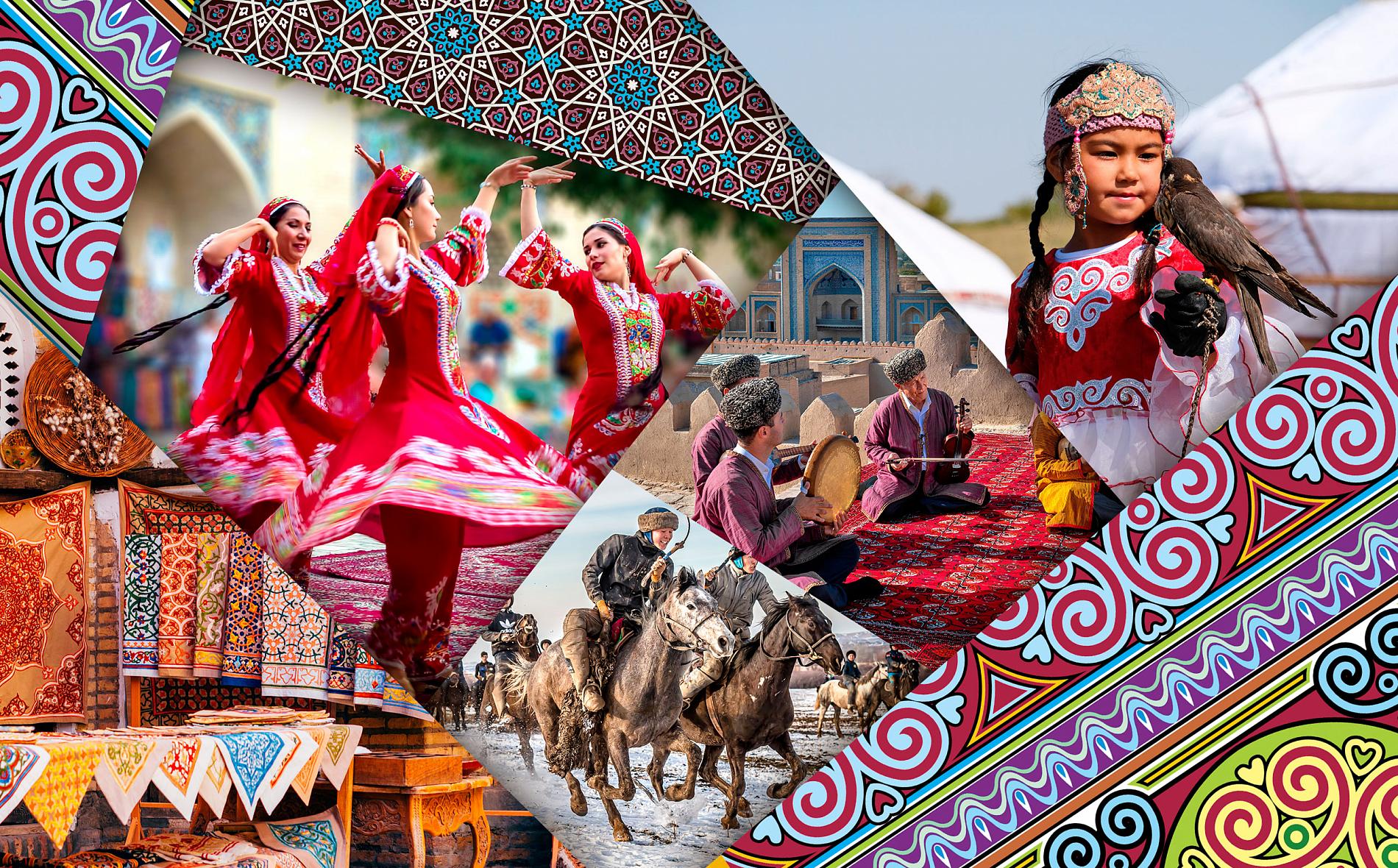In light of the current global trends and the changing dynamics in geopolitics, it is advantageous for Central Asian countries to develop a unified sense of shared values and objectives.
In recent years, Central Asia has experienced a surge in regionalism, prompting discussions on the formation of a regional identity. This topic gained significant attention during the Central Asia Media Forum in Astana in December 2022, where representatives from countries such as Uzbekistan and Kyrgyzstan emphasized the importance of citizens feeling a sense of belonging not only to their own countries, but also to the broader Central Asian region.

Photo credit: etnomir.ru.
In light of the current global trends and the changing dynamics in geopolitics, it is advantageous for Central Asian countries to develop a unified sense of shared values and objectives, similar to regional blocs such as ASEAN or the Nordic countries. The five Central Asian states share a common history, religion, culture, and worldview, and also confront similar socioeconomic and political challenges. By building upon these commonalities, they are more likely to foster a sense of shared identity.

Alouddin Komilov
This can be achieved by actively promoting a regional cultural ecosystem, encouraging interregional business activities, and creating a common media space within Central Asia. These all would facilitate interactions and connections among the people of the region and help individuals identify themselves with the region as a whole, rather than solely with their individual nations. As a result, Central Asian countries would foster a sense of shared identity and cooperation among themselves.
The promotion of regional cultural ecosystem
Central Asia countries should foster a sense of shared identity by strengthening the regional cultural ecosystem based on common cultural values and traditions. Cultural goods and services should not only be produced and consumed within each nation, but also shared and exchanged across the region. This will create a network of cultural interactions that can enrich and influence each other. By strengthening the regional cultural ecosystem, Central Asian nations can foster a regional identity that does not erase their national identities but instead builds upon them. The regional identity should be based on recognizing and appreciating the diversity and uniqueness of each nation’s culture, as well as the commonalities and similarities they share. Therefore, the nations in Central Asia should preserve and nurture their unique cultural expressions while also collaborating and exchanging with each other.

Ozod Tanbaev
To achieve this, Central Asian countries can adopt some of successful and relevant experience of ASEAN in developing a regional cultural ecosystem. They can encourage the development of civil society organizations that promote cultural exchange and the preservation of common cultural heritage. For instance, they could organize joint cultural festivals that showcase the rich heritage, music, dance, and cuisine of each Central Asian country. Language exchange programs could also be promoted to facilitate understanding of different Central Asian languages. Historical exhibitions could further help people in the region to realize their shared historical and cultural heritage. Additionally, the countries in the region should collaborate in the preservation and restoration of not only historical sites and monuments but also traditional art, music, and crafts that are unique and significant to the entire region. All of these efforts would enhance the formation of regional identity in Central Asia.
The promotion of interregional business activities
Central Asian countries have an opportunity to foster a shared regional identity by supporting interregional business and entrepreneurship activities. Throughout history, bazaars have served as vibrant hubs for exchanging culture and information among people, playing a significant role in the rich tapestry of Central Asian countries. These marketplaces in Kokand, Khujand, Bishkek and Turkistan were not merely venues for trading goods and services; they were centers where people interact, communicate, and learn from one another. While traditional bazaars might be fading, their spirit can be revived through small and medium-sized businesses, which not only provide employment, income, and innovation but also contribute to social cohesion. These businesses have the potential to nurture mutual trust, understanding, and friendship among the diverse people of Central Asia.
In addition to bolstering regional economic cooperation at the state level, Central Asian nations should collaborate to facilitate trade agreements and economic partnerships among their businesses. By offering policy support, investing in infrastructure development, streamlining trade facilitation, and establishing efficient dispute resolution mechanisms, these countries can create a favorable environment for local entrepreneurs. Removing barriers to entry, improving access to finance, enhancing legal protection, and promoting social responsibility will further enhance this environment, encouraging joint business ventures and cross-border investments involving entrepreneurs from different countries within the region.
Central Asia possesses a substantial market potential, with an approximate population of 80 million. This population is not only sizable but also young, dynamic, and relatively well-educated. They have a growing demand for goods and services that can enhance their quality of life and contribute to sustainable development. By nurturing interregional business and entrepreneurship activities, Central Asian nations can tap into this potential, fostering a collective regional identity among their people. This approach not only strengthens economic collaboration but also creates a sense of unity and pride among the diverse cultures that call Central Asia home. By capitalizing on their shared heritage and promoting cross-border business initiatives, Central Asian countries can pave the way for a prosperous and interconnected future.
The creation of common media space
Creating a common media space in Central Asia is a pivotal factor in the ongoing process of regional identity formation. To achieve this, the nations in the region should prioritize the establishment of a regional media network that utilizes regional languages. This network’s primary objective should be to not only propagate positive stories and collaborations within the region but also to amplify awareness regarding the shared history, values, and aspirations of the Central Asian nations. This collective effort will be instrumental in fostering a profound sense of belonging, mutual understanding, and enhanced cooperation among the diverse people of Central Asia.
Moreover, a regional media network plays a vital role in launching impactful public awareness campaigns. These campaigns should focus on social, political, and economic processes in neighboring countries, aiming to dismantle prevailing stereotypes about various ethnicities and communities. This initiative is especially important for entrepreneurs and business circles seeking to engage in trade with regional states. Access to comprehensive information about the economic landscape, investment opportunities, available resources, and market demand within neighboring countries is essential. Without reliable and timely information, these stakeholders cannot make well-informed decisions or harness the full potential of regional trade. The absence of a common information space severely hampers the overall development of the region.
Last but certainly not least, the establishment of a Central Asian media network employing regional languages serves as a crucial means of coordinating policies, strategies, and actions in pursuit of common regional goals and the mitigation of shared challenges. It is paramount that a shared media platform be created to deliver accurate, unbiased information and facilitate constructive dialogue among the region’s inhabitants. This platform will be key to countering the detrimental effects of fake news and foreign propaganda, which can otherwise undermine local initiatives and sow discord. Such a platform is pivotal for enabling the formation of well-informed opinions and facilitating sound decision-making among the populace. In essence, a common media space in Central Asia is not just a necessity; it is a foundation upon which a stronger, more interconnected regional identity can be built.
In conclusion, the formation of collective regional identity is a significant factor in Central Asian regionalism. By nurturing a regional cultural ecosystem, promoting interregional business activities, and creating a common media space, Central Asian countries can strengthen their sense of shared identity. These efforts will foster trust, unity, and cooperation, leading to enhanced cooperation and potentially integration among the five countries in the region. Building upon their commonalities while appreciating their differences, Central Asia countries has the potential to create a prosperous and interconnected region.
The authors are research fellows Alouddin Komilov and Ozod Tanbev at the Center for Progressive Reforms in Uzbekistan.
The article was originally published in the Modern Diplomacy media platform.
Disclaimer: The views and opinions expressed in this article are those of the author and do not necessarily reflect the position of The Astana Times.


